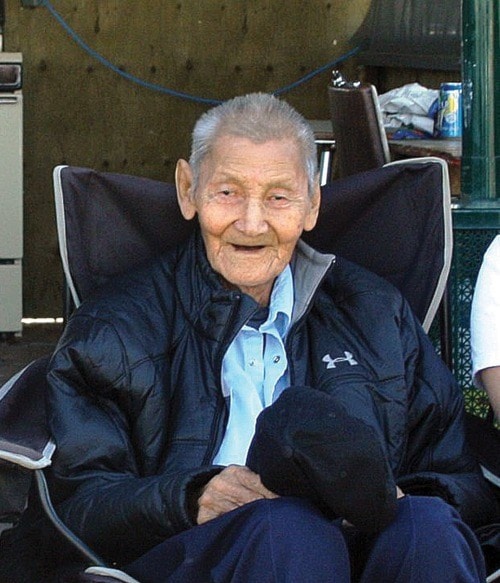In 1916 stainless steel was invented by Henry Brearly. The pop up toaster was not invented until three years later and a zipper for clothes and crayons were brand new inventions.
This was also the year that Southside resident Thomas Morris was born.
He recently celebrated his 95 birthday with family and friends at a gathering held at Beaver Point Resort.
Born in the Stellako area on July 9, 1916, he grew up on the land trapping as a young boy with his mom Amanda (Peters) Morris in the areas of Binta Lake, Uncha Lake, Grassy Plains, Ootsa Lake, Thatsa, Morice Lake, Nanika Lake and Nadina Mountain.
Thomas credits his mom as a strong woman who taught him a lot of what he knows today.
He also had a brother Frank, who, he says, passed on at a young age.
He does not recall too much about his schooling, other than attending the Lejac Residential School.
According to his son, Ray Morris, Chief of the Nee Tahi Buhn Band, "All he remembers about his school life is clearing the land on the West side of the school site."
Thomas says he was at the Lejac Residential School for between two to five years and when he returned home he went back to trapping. His favorite childhood memories are of his time spent with his mom, who he said, was laid to rest in Burns Lake.
Family homes were slab and tar paper buildings with wood heat, and during the early years of his life a place to sleep was under a spruce tree or a lean to on one of his trap lines.
Growing up, Thomas worked in the forest industry tie hacking, saw milling and logging and enjoyed bareback horse riding.
"He won a few prizes in the rodeo circuit in his early years," said his son Ray.
He trained for the Canadian Army in Wainwright, Alberta for the second World War and during this time his mom wrote a letter to the Army asking them to return her son, as he was her only son.
"When his comrades were receiving their gear for overseas, he asked where his gear was. He remembers his sergeant telling him you can't break your mom's heart. She sent a letter, so you are not going overseas," Ray said.
He remembers cutting firewood for Japanese prisoners in Vernon. He would cut the wood and the Japanese prisoners would pile it ready for use in the town. He also recalls unloading ammunition in Kamloops B.C. "This probably took place after returning from Wainwright," Ray added.
Thomas built homes for Henry Amendt and other farm buildings, installed a chimney in Hoyt Burts home at Barkers Meadow and worked a sawmill with Hoyt Burt. In his later years he was a production hand faller at Eurocan Andrew Bay, East Ootsa logging camp, retiring as a hand faller at the age of 65.
One of the challenges of growing up in the local area was getting food to families throughout the territory. Thomas and his father would check up on the Skins and Andrews families and bring them groceries or hunt moose for them and make sure they survived through the winters.
"He recalls potlatch coming in from the Western First Nations in the early 1920s to 1930s . A First Nations camp used to be across the road from Grassy Plains Hall where campers came from across the country.
Today that camp site is identifiable as a growth of popular trees in the Reedy's field. All this land in Grassy Plains was cleared mainly by First Nations who came and camped in the field across from the hall site," Ray said.
Buying tools for working on the land would mean a trip to Bella Coola had to be made and groceries were bought in Hazelton as the smaller ships from the coast could only come inland to Hazelton.
"All the First Nations from Nautley and Stellako had to travel to Hazelton for groceries."
Thomas dug a water line for a pioneer on the Northside of Francois Lake working for 50 cents per day for three weeks and compared this work to trapping. During this same period he caught a fisher and made $75 off just one catch.
During the 1920's and 1930's the work was hard and the pay was low, between 20 to 50 cents a day.
He now faces new challenges as his life long friends have all passed on.
"At times he gets lonely for his companions," said Ray.
One big change over his lifetime was medical procedures. "He had a pace maker put in about three years ago and he didn't want the surgery until his grandson Jesse explained to him the procedure used today for a pacemaker. Once he understood it was a small pocket cut, he decided to have the surgery," his son Ray added.
Thomas has spent a lot of his last 15 years studying the bible in his spare time.
